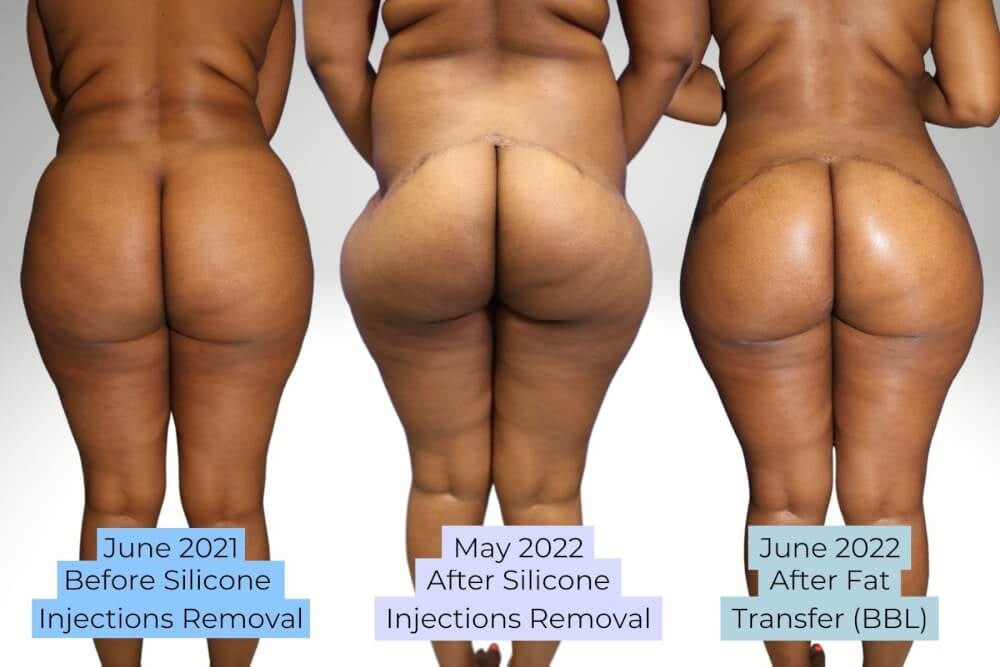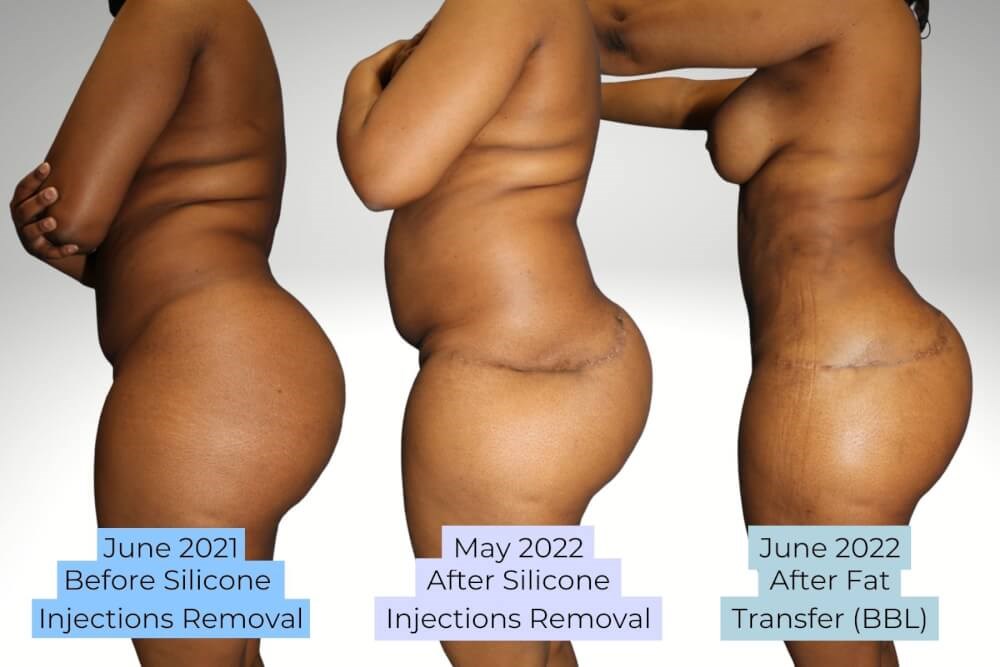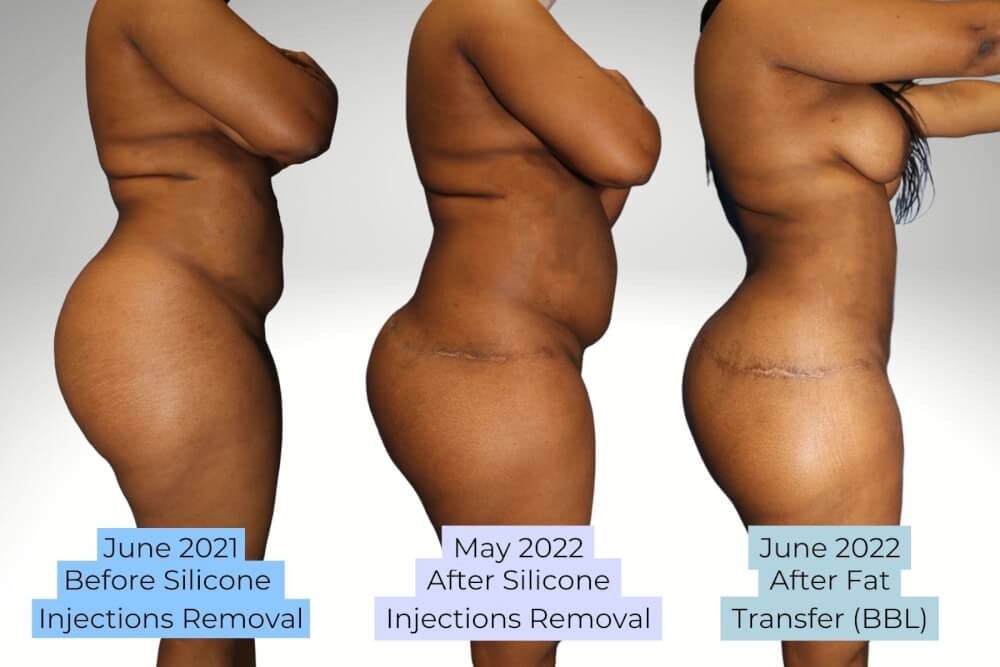When and Why Should I Remove my Injected Silicone?
8/24/2022
Illegal injections cause many complications like pain, skin changes, migration, and the creation of granulation tissue.This article stresses the importance of removing illegal injections early and before complications arise.
Why should I remove injected silicone? When should I get my injected silicone removed?
Unfortunately, many people were tricked and duped into obtaining illegal injections in their buttocks, breast, face, or lips. As a result, after your injections, you may feel alone and ashamed and not knowing who to trust for advice. Also, there are many false claims and rumors about when to remove illegal silicone injections. These false claims led to many patients being confused as to when and why to have their illegally injected products removed.
Unfortunately, silicone is a permanent product. Illegally injected silicone will not dissolve, and your body will not absorb the product. Your body treats silicone as a foreign substance. Injected silicone elicits an inflammatory response stimulating the creation of antibodies and scar tissue. As long as silicone is in your body, your immune system tries to isolate the silicone and reject it. Over time, this can lead to complications. This article stresses the importance of removing illegal silicone injections early and before complications begin.
The most common complications of silicone injections are localized and referred pain, skin changes, migration, and development of excess scar or granulation tissue. Let us explore each complication.

Before and After
1) Pain. Pain from illegal silicone injections is thought to be caused by three different mechanisms: direct toxicity to the nerve, compression of the nerves, and complete encasement of nearby nerves. After the silicone is injected, the silicone product can cause direct nerve irritation due to the chemical nature of silicone and its impure contaminants. This type of pain is thought to be caused due to release of silicone toxins close to the nerve. The second type of pain is caused by the creation of scar tissue around the injected silicone. As scar tissue accumulates, the scar tissue can directly press on the surrounding muscle and nerves. Direct pressure of the scar tissue on the nerve elicits localized pain. Also, scar tissue can cause referred pain. Referred pain occurs when pressure on a nerve in one area produces pain in another part of the body. Localized and referred pain are commonly seen in illegal silicone injections. Localized pain results in buttock pain. Referred pain occurs when scar tissue builds and presses on the sciatic nerve. The sciatic nerve runs through the body and innervates the back of the leg. Compression of the sciatic nerve due to silicone-induced scar tissue formation leads to radiating leg pain. This type of radiating leg pain is called sciatica.
The third type of pain that occurs after silicone injections is when the scar tissue surrounds the nerve. This scar tissue causes a constricting, enveloping nerve pain. Illegal buttock silicone injections can lead to localized buttock pain or even referred pain as the scar tissue wraps around the sciatic nerve.
Unfortunately, there is no healthy way to decrease scar tissue formation. Steroids are a temporary measure and do not fix to root cause of the problem. Therefore, eventually, silicone injections will lead to scar tissue and pain. Thus, removing the silicone early and before scar tissue and subsequent pain development is better than waiting for symptoms like pain to worsen.

Before and After
2) Skin changes. As mentioned, an inflammatory response is initiated as soon as the silicone is injected. After your body walls off the silicone, it tries to reject the foreign body. It is thought that your body sends chemical messages to the skin to create a path or tunnel to reject the walled-off silicone. Unfortunately, the silicone becomes trapped in the scar tissue or the skin's pores. This trapped silicone can appear as purple areas of skin around the injected sites. Furthermore, when there is an acute infection of the silicone injections, the surrounding buttock skin can turn red and become extremely painful. Chronic skin infections can create problems like scar tissue and decreased blood supply. Only about 50% of skin problems correct after silicone removal surgery. Given enough time, some chronically infected skin can lose blood supply and die. This dead, black skin is called necrotic skin. Skin necrosis may require emergency surgery. Therefore, it is best to remove silicone injections before you develop skin issues.
3) Migration. Over time, the injected silicone works its way into the lymphatic circulation. Once the silicone reaches the lymphatic circulation, the product can migrate throughout the body. Eventually, the product becomes filtered in lymph nodes in the groin. It is not uncommon to see silicone products injected into the buttock migrate over the hips and into the groin. Alternatively, the product can follow gravity inside or outside the lymphatic circulation. Often, silicone products injected into the buttock can travel into the labia or scrotum and migrate to the ankles and feet within several months. Once the silicone product leaves the initially injected cavity, it becomes much more challenging to treat. If the silicone product spreads, that means a more extensive surgery with potentially more incisions to remove the product. Also, silicone removal surgery on the calves, ankles, and feet is far more complicated than silicone product removal from the buttock. Therefore, removing the injected product from the original injection site is best, as opposed to waiting until it spreads to other body parts.

Before and After
4) Creation of granulation tissue. Immediately after the silicone is injected, your body creates an inflammatory response and foreign body reaction. This foreign body reaction never lessens. Over time, the foreign body reaction becomes more severe and advances. The foreign body reaction is the creation of scar tissue around the injected silicone. Scar tissue is created to wall off the silicone and keep the product from being exposed to the body. Over time, sometimes, there are cracks and breaks in the scar tissue leading to silicone leakage and the creation of even more scar tissue. Initially, there are spheres or balls of scar tissue around the injected silicone droplets. Over time, these spheres collect, fuse, and form a large mass of scar tissue. With the high cellular turnover, mistakes are made in the cellular transcription of scar tissue creation. These cellular mistakes lead to the formation of granulomas. These granulomas cause excessive scar tissue and create a disproportionate buttock compared to the amount of injected product. That is why your buttock may double in size over a year. Another reason to remove the silicone early is to minimize the chances of excessive scar tissue creation and granuloma formation. The longer you wait, the more scar tissue is created, and the more complex the silicone removal surgery becomes.
Conclusion: Silicone injections are not a wise idea. Unfortunately, once the silicone is injected, your body immediately begins its foreign body reaction. This foreign body reaction continues until the product is surgically removed. Therefore, before symptoms occur like pain, skin changes, migration, and changes to granulation tissue, please seek a plastic surgery specialist to have the silicone removed.